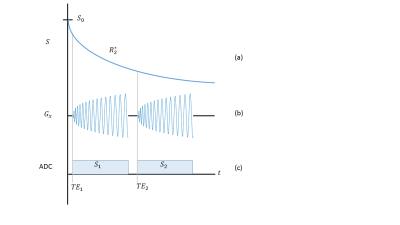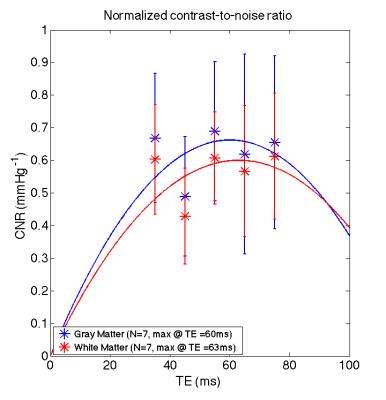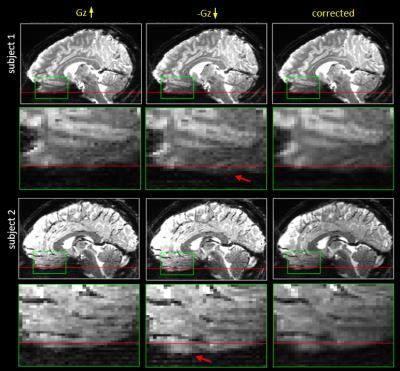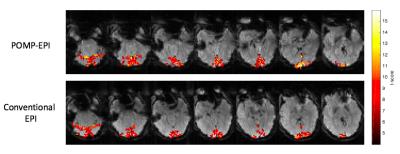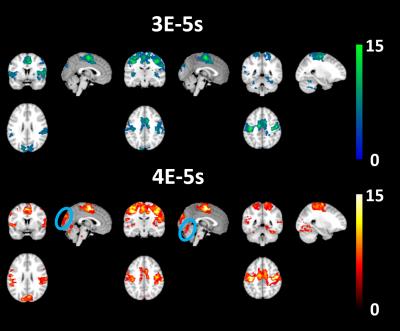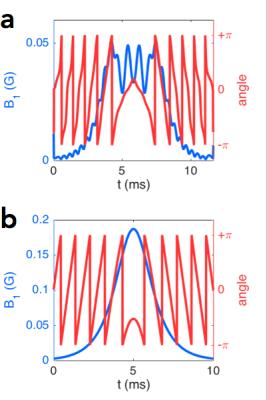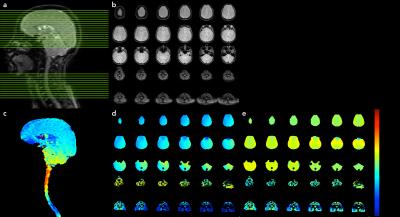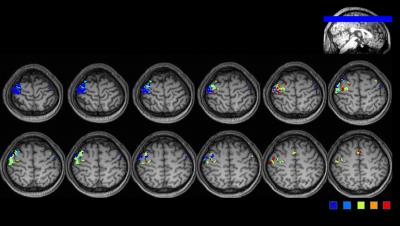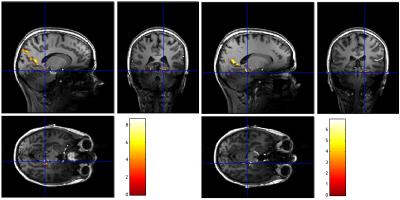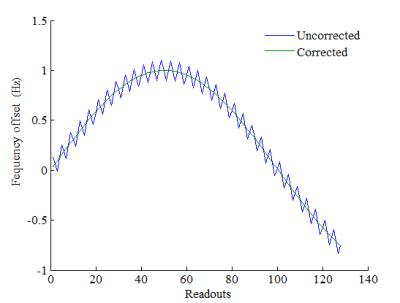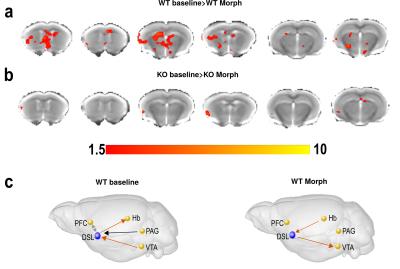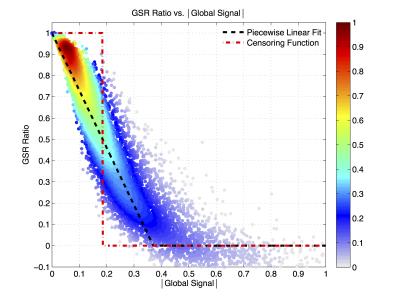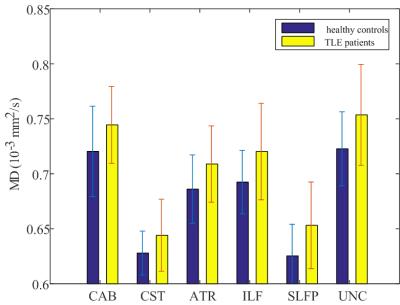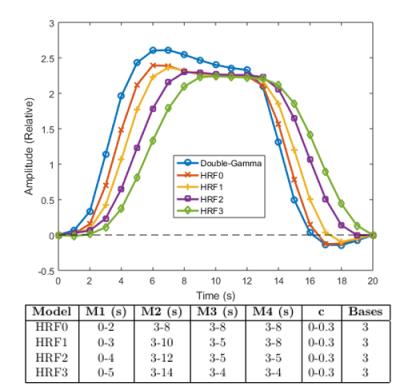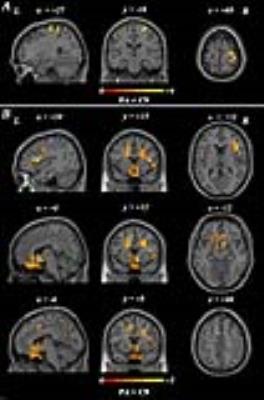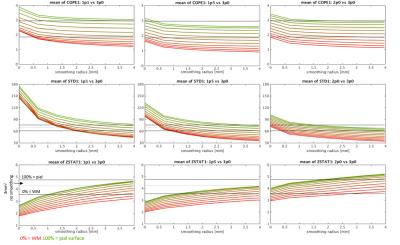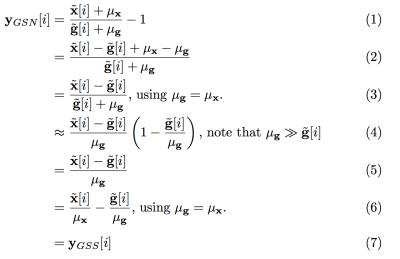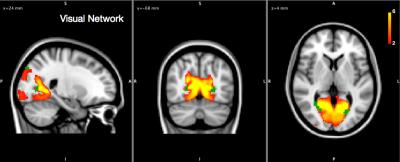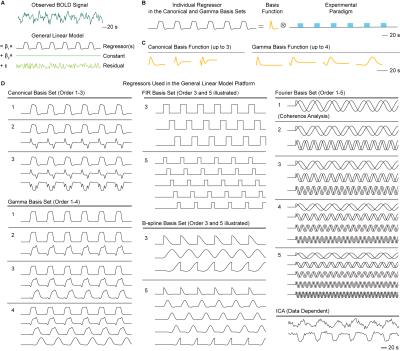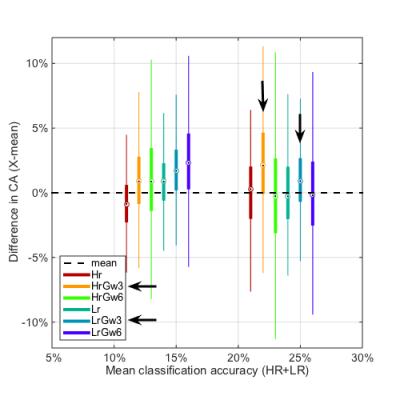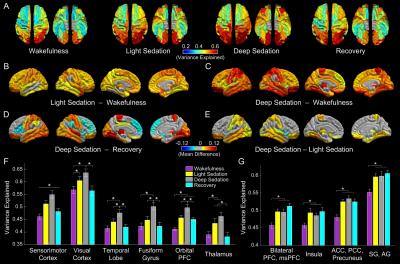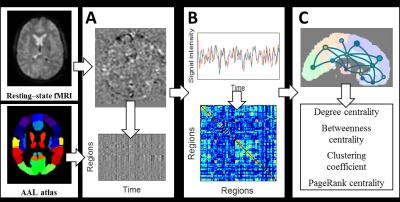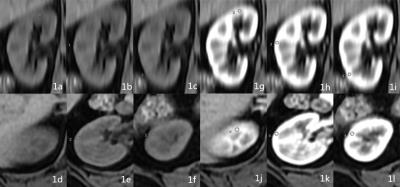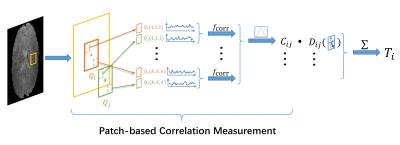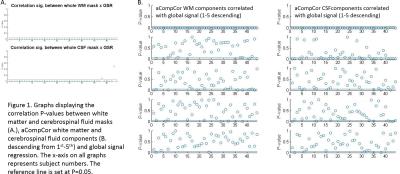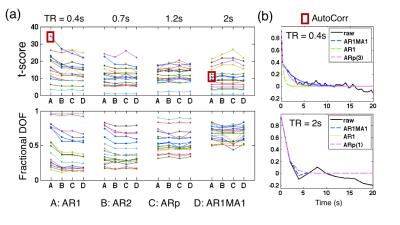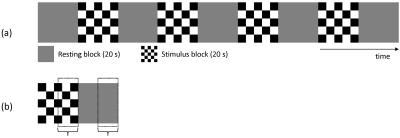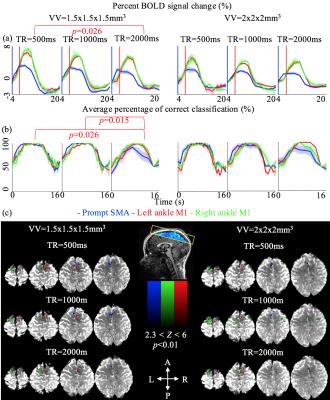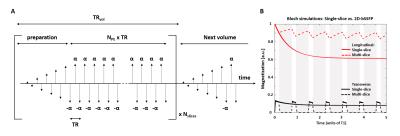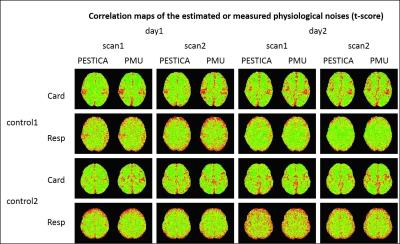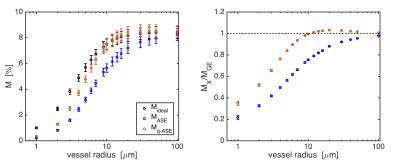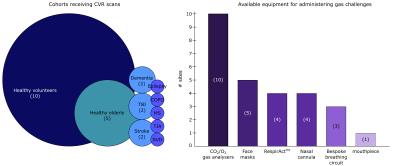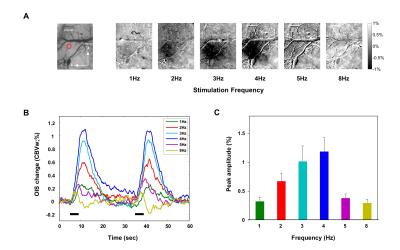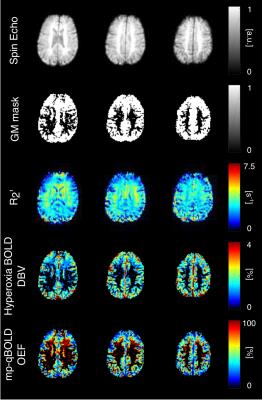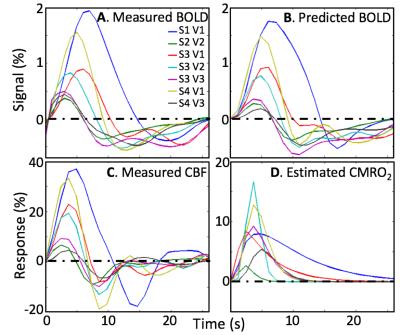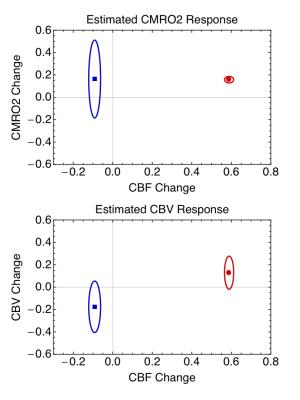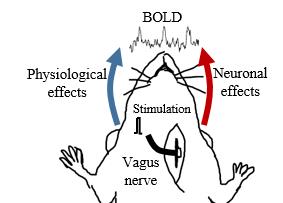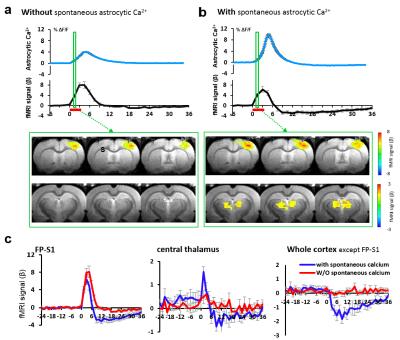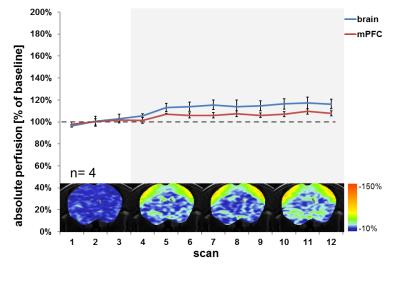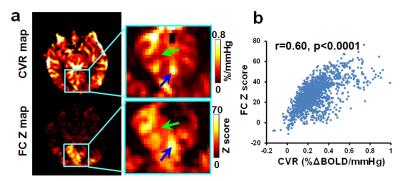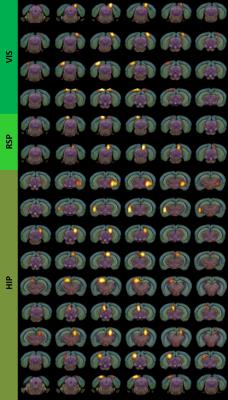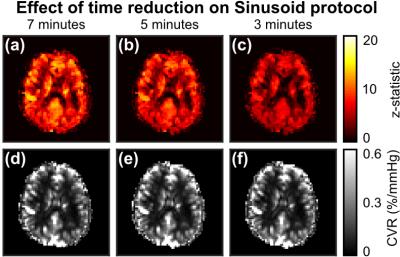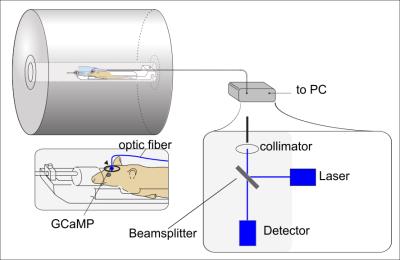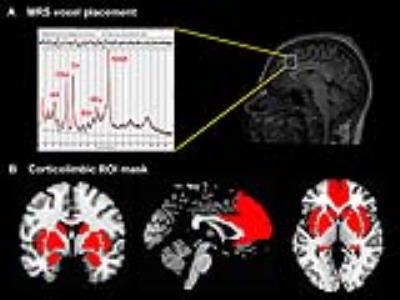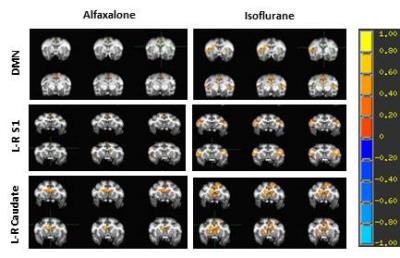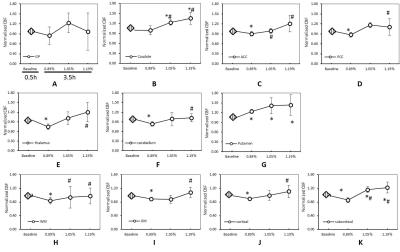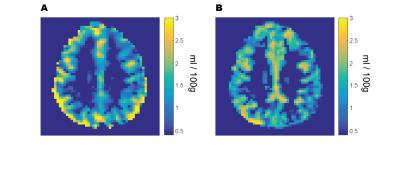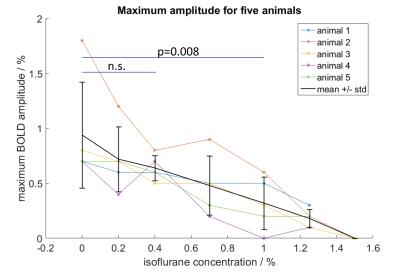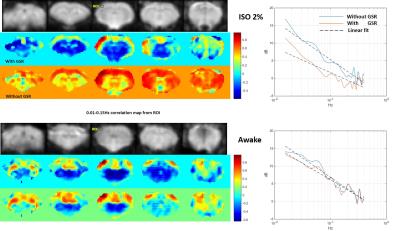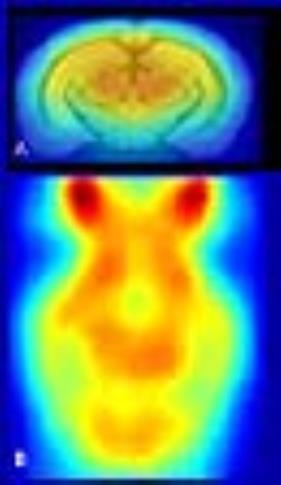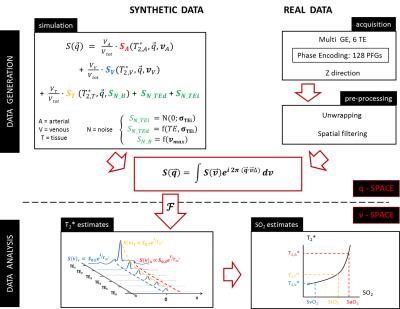fMRI: Neuroscience Applications
Traditional Poster
fMRI
Tuesday, 25 April 2017
| Exhibition Hall |
08:15 - 10:15 |
|
1686.
 |
Radiation-induced Brain Abnormalities: Plasticity, Progression and Outcome Prediction
Han Zhang, Dinggang Shen
Brain plasticity is fascinating and important to our life. Radiation therapy can cause brain injury which may cover or progress, posing an ideal case to study brain plasticity. We used a rare and unique cohort of nasopharyngeal carcinoma patients with normal-appearing brains to study irradiation injury in its preclinical stage in context of brain functional and structural plasticity. We found an acute increase in local brain activity, followed by its extensive reduction; and significant functional connectivity loss in the default mode network. Such radiosensitive functional alterations were intriguingly found to be plastic. By contrast, a progressive late disrupted integrity of the related white matter was starting to be significant after one year at the far end. Early increased local brain functional activity was able to predict severe later brain necrosis through a bridge of brain connectome. These findings highlight the importance of brain connectomics in translational clinical study.
|
|
1697.
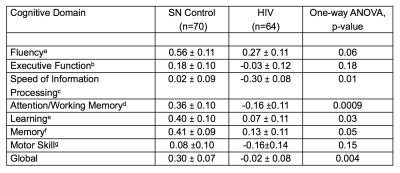 |
Greater Connectivity Between Cerebellar Vermis and Insular Attention Resting Network in HIV Patients
Steffan Soosman, Thomas Ernst, Linda Chang
Individuals infected with HIV frequently have HIV-associated neurocognitive disorders (HAND), despite effective plasma viral suppression. Various resting state networks studied with fMRI have been shown to be attenuated in HIV compared to seronegative controls. This study shows an increased connectivity in HIV subjects between the cerebellar vermis and bilateral insulae. Using clinical correlates, we conclude that this increased connectivity may be due to decreased efficiency in functional connectivity in the HIV-infected brain.
|
|
1687. 
 |
Pediatric Brain Functional Parcellation from Birth to 2-Years-Old
Weiyan Yin, Weili Lin
Brain functional parcellation has been shown to discern brain functional atlases in adults. In this study, multigraph K-way clustering1 was employed to reveal temporal evaluation of brain funcitonal atlases in 71 healthy children longitudinally scanned at 1/3/6/9/12/18/24 months of age. Results revealed temporal evolution of brain functional networks during the first two years of life.
|
|
1699. 
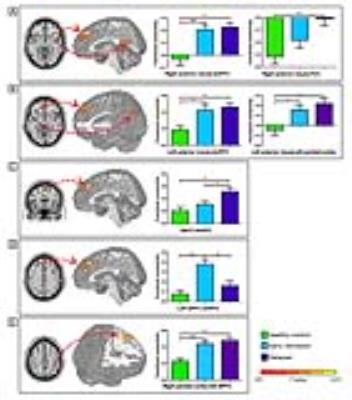 |
Impaired interactions of large-scale networks predict relapse behavior in heroin-dependent individuals
Qiang Li , Jiajie Chen, Jierong Liu, Wei Li, Wei Wang
Coupling of large-scale brain networks may underlie cognitive dysfunction in psychiatric disorders including addiction. However, whether the deficit of interactions among large-scale brain networks is associated with relapse behavior of heroin addiction remains unknown. This is the first neuroimaging study to assess coupling of large-scale networks that predict relapse in heroin addiction. In this study, we utilized a resting-state functional connectivity method of functional magnetic resonance imaging and found that abnormally higher functional connectivity between the SN and DMN, and lower functional connectivity between the left ECN and DMN were associated with the relapse behavior in treated heroin-dependent patients.
|
|
1685.
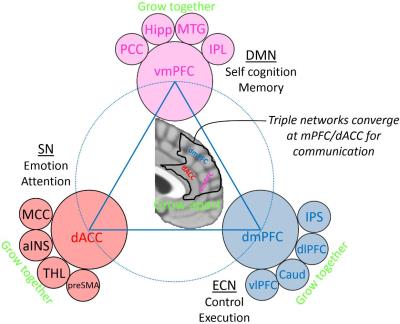 |
Growing Apart or Growing Together: a Novel “Developing Triple Network” Hypothesis for Baby Connectome Study
Han Zhang, Weiyan Yin, Weili Lin, Dinggang Shen
For baby connectome study, we propose a “developing triple network” model based on our findings from precious longitudinal infant resting-state fMRI data, which extends previous “triple network model” to 0-2 years old, a pivotal period which we have little knowledge on. Our developmental model provides future study with key information on early functional connectivity. We found medial prefrontal area is growing apart and its long-range FC is growing together at different speeds in the first 2 years. We, for the first time, found a novel early developmental pattern with both local and long-range FC increases at 6-9 months but decreases afterwards, indicating pivotal neural pruning mechanism from system neuroscience view point.
|
|
1709.
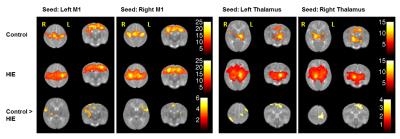 |
Disruption of Functional Connectivity in Neonates with Hypoxic Ischemic Encephalopathy at Term
Li Jiang, Jiachen Zhuo, Dina Metwally, Rao Gullapalli, Prashant Raghavan
Perinatal hypoxic-ischemic encephalopathy (HIE) is one of the most common causes of severe, long-term neurologic deficits in children. Up to 40% of infants with HIE who present minimal to no abnormality on structure MRI may still have manifest neurological deficits in later life. In this study, we hypothesize that functional connectivity (FC) of the brain in infants with HIE at term may be altered and that resting-state functional MRI (rs-fMRI) may provide deeper insights into the altered nature of the brain networks, especially the motor network and the thalamocortical network in infants with HIE.
|
|
1700.
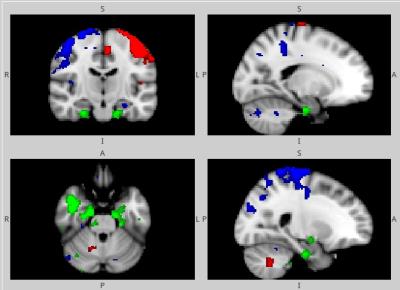 |
Localization of the epileptogenic neural network by the resting state fMRI in patients with the temporal lobe epilepsy
Oleksii Omelchenko, Mykola Makarchuk, Volodymyr Rogozhyn
Precise localization of the epileptogenic zone and its delineation from eloquent cortex, are crucial for successful surgery. We propose analysis of macroscopic brain neural networks connectivity in the resting state and during the movement execution in patients with TLE for the possible epileptogenic macroscopic neural network localisation and motor cortex mapping. Our results show the concordant topography of the resting state network and the EEG epileptiform activity. Resting state fMRI could potentially depict the epileptogenic neural network in TLE which includes regions of temporal lobe and hippocampus. Motor network was shown to remain unaffected in TLE during interictal period.
|
|
1684.
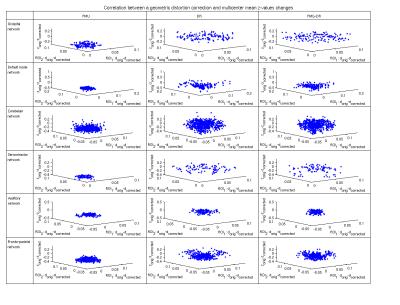 |
The impact of geometric distortion correction on multisite rs-fMRI data
Nicolas Hehn, Ana Beatriz Solana Sánchez, Dirk Bequé, Nikolaos Koutsouleris, Axel Haase, Bjoern Menze, Carlos Cabral
This study addresses the goal of reducing site-variance in the correlation values of multisite rs-fMRI data by correcting for site-specific EPI-related geometric distortions. Three geometric distortion correction methods (B0 fieldmap and image-based unwarping) were applied separately to a calibration dataset consisting of six subjects traveling to three sites. The change of the correlation values and their site-homogeneity was evaluated in dependency of the quantified geometric distortion correction values for six networks and all subjects. It could be shown that the distortion correction had no significant impact on the correlation values and no correlation between the two parameters was found.
|
|
1701. 
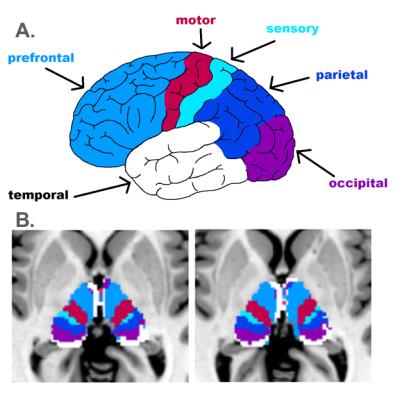 |
Higher Thalamocortical Connectivity May Reduce Efficacy of Temporal Resection
Bryson Reynolds, Jasmine Sondhi, Monica Giraldo-Chica, Baxter Rogers, Bennett Landman, Bassel Abou-Khalil, Adam Anderson, Victoria Morgan
Functional connectivity of the thalamus could inform the potential efficacy of temporal resection in temporal lobe epilepsy. Diffusion and functional MRI was collected from 22 patients who underwent surgical treatment for temporal lobe epilepsy. The thalamus was segmented into six subregions based on diffusion tractography to six regions encompassing the entire cortex. Functional connectivity was calculated between each thalamic subregion and cortical region for each patient. Higher functional connectivity between the contralateral temporal-thalamic subregion and the cortex was associated with seizure recurrence after surgery.
|
|
1702.
 |
Disrupted Cortical Modulation of Hypothalamus Functioning for Visceral Homeostasis in Patients with Irritable Bowel Syndrome
Xiaolin Liu, Shi-Jiang Li, Reza Shaker, Alan Silverman, Mark Kern, B. Ward, Gisela Chelimsky, Manu Sood
The hypothalamus plays a critical role in maintaining visceral homeostasis. We evaluated, using functional imaging, hypothalamus functional connectivity in adolescent IBS patients and controls who received rectal distension stimulations. More extensive hypothalamus connectivity was observed in liminal than subliminal condition in controls, but not in IBS patients. Compared with controls, IBS patients showed significantly reduced hypothalamus connectivity in the bilateral prefrontal cortices, supplementary motor and premotor areas, bilateral sensorimotor cortex, and limbic subareas, which are specifically involved in homeostatic regulation. The findings support that reduced cortical and limbic modulations of hypothalamus functioning underlies disrupted visceral homeostasis in IBS patients.
|
|
1729. 
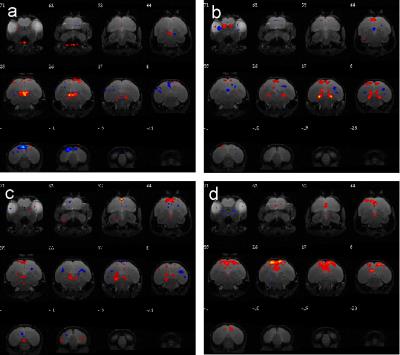 |
Functional magnetic resonance imaging shows network activation from a non-visual light stimulus of deep brain photoreceptors in songbirds
Bruce Langford, Thomas Neuberger, Nanyin Zhang, Paul Bartell
Many avian species go through circannual changes in reproductive organs. Seasonal changes are triggered by non-visual photostimulation, made possible by the existence of nuclei with containing opsin channels. Photoactivation occurs when photosensitive neurons are stimulated, resulting in a cascade of activity in the brain, which initiates gonadal growth. Photorefraction is on a time-scale much longer than an experiment. We used echo planar imaging fMRI with a laser for stimulation and performed independent component analysis on each phase (before, during, and after stimulation). Network activation patterns differ in each phase.
|
|
1689. 
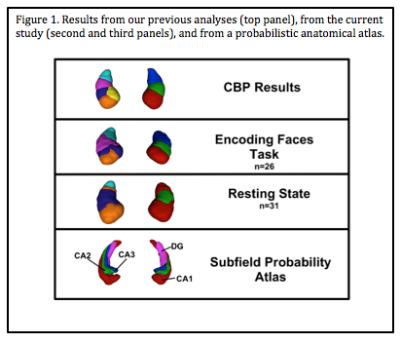 |
Neurofunctional topography of the human hippocampus: Converging data from a series of studies
Jennifer Robinson, Jessica Busler, Meredith Reid, Nouha Salibi, Xinyu Zhao, Gopikrishna Deshpande
The hippocampus, one of the most phylogenetically preserved structures in the human brain, has been a topic of interest to evolution theorists and cognitive neuroscientists alike. Malfunctions in the hippocampus are hallmark features in a number of psychiatric and neurological conditions, further amplifying interest. Little advancement has been made regarding the neurofunctional topography of the structure. We used high-field, high-resolution neuroimaging techniques to demonstrate convergent evidence on a new theory of hippocampal organization. Data from this project are expected to catalyze efforts in neuroscience and medicine to better understand hippocampal functioning and promote the identification of healthy and aberrant signaling.
|
|
1691.
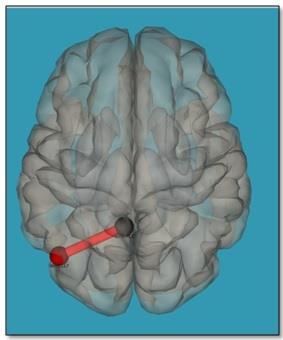 |
Connectivity of the Default Mode Network – Prior and post an oddball paradigm
Irene Neuner, Ravichandran Rajkumar, Shukti Ramkiran, Tracy Warbrick, Jorge Arrubla, N Jon Shah
The DMN is shown to be highly active during resting state and is rapidly deactivated during externally directed tasks. However, it is unclear how demanding the task needs to be to switch the DMN out of the resting state mode. Aiming to answer this question we chose a visual oddball paradigm and assessed the functional connectivity of the DMN during resting state in a rest-task-rest design. The oddball paradigm demands very little cognitive resources and therefore we hypothesize that the DMN will not be altered in its connectivity pattern during post task resting state.
|
|
1703.
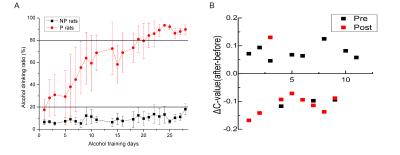 |
Patterns of the whole brain default mode network for alcohol addiction among the alcohol preferring rats
Yue Liu, Ning Zheng, Taotao Liu, Binbin Nie, Jie Wang, Fuqiang Xu
Alcohol preferring and non-preferring rats were trained with two-bottle choice methods. The whole brain default mode network was acquired during different period of addiction training and after alcohol injection. The correlation coefficients among 28 regions were calculated by mean-value of Pearson correlation. The changes of brain connections after alcohol consumption in different stage of alcohol addiction is significant different. Furthermore, some addiction or reward associated regions and new possible areas (NAc, Tu, VTA, IC, Hypo, SNC, Au, DB, Hipp, VLPO, etc.) showed difference during the training. Our findings could provide preliminary functional connection support of neurobiological circuits change.
|
|
1696.
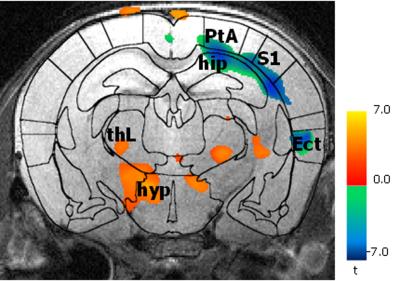 |
Low-dose radiation disrupts functional brain connectivity during nociceptive heat stimulation in a mouse model
Silke Kreitz, Sandra Strobelt, Michael Uder, Andreas Hess
Due to improved medical techniques such as CT and radiotherapy todays children are more exposed to low-dose radiation than previous generations. However, little is known about the influence of low-dose radiation on the brain’s development. We hypothesize that altered functional connectivity of activated areas during pain processing can serve as a marker for disturbed brain development. In a mouse model we showed that functional connectivity during nociceptive stimulation after P10 irradiation is disrupted in cortical areas that mature postnatal. We could demonstrate that pain processing is influenced by low-dose irradiation which is in concordance with the brain’s developmental state.
|
|
1704.
 |
Cocaine applied in a “binge paradigm” induces a region-specific and persistent brain circuitry modulation.
Elisabeth Jonckers, Michael Belloy, Dany Dsouza, Marleen Verhoye, Thomas Mueggler, Annemie Van der Linden
Our pre-clinical rodent study showed an increased Functional Connectivity at the level of the striatum and the cingulate cortex induced by cocaine injection. The effect was detectable 4 hours after administering cocaine and sustained for 24h.
|
|
1705.
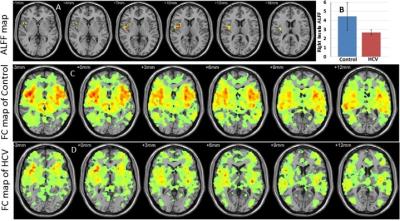 |
Resting state fMRI in Patients Infected with Hepatitis C Virus
Santosh Yadav, Ajay Vardaan, Rakesh Gupta, Pradeep Gupta, Samir Mohindra, Deepak Kaura, Francesco Marincola, Ena Wang, Mohammad Haris
Current study measured the amplitude of low-frequency fluctuations (ALFF) and insular functional connectivity (FC) in Hepatitis C virus patients and compared with age and gender matched control using RESTplus software. HCV patients showed significantly reduced ALFF in the right insula. The right insular FC strength was lower in patients than control. Neuropsychological test scores were significantly lower in HCV patients. Changes in ALFF and FC provide new evidences of altered neuronal activity in HCV patients.
|
|
1706. 
 |
Resting state fMRI in Migraine
Kenneth Jackson, Steven Liu, Maryam Falahpour, Christy Jackson, Frank Haist, Richard Buxton, David Dubowitz
We used resting state fMRI to evaluate changes in functional connectivity during migraine episodes, and the response to treatment. The results provide preliminary evidence for a change in functional connectivity in the DMN during migraine, and for the ability of serotonin agonists to restore resting state connectivity. We also identified key brain regions impacted by migraine and then normalized following sumatriptan.
|
|
1698.
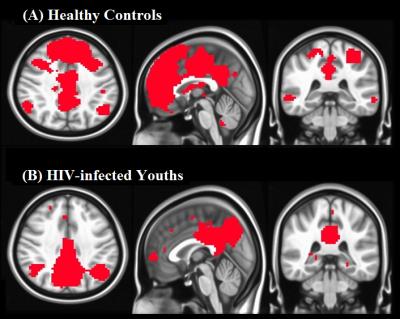 |
Resting State Brain Networks in Perinatally HIV-infected Adult Youths
Manoj Sarma, Bharat Biswal, Margaret Keller, Tamara Welikson, Irwin Walot, David Michalik, Karin Nielsen-Saines, Jaime Deville, Andrea Kovacs, Eva Operskalski, Joseph Ventura, M. Albert Thomas
Youths with perinatally infected HIV survive longer with combination antiretroviral therapy, but remain at risk for poor cognitive outcomes. Since changes in cognitive function may be preceded by subtle changes in brain function, resting-state functional magnetic resonance imaging (rs-fMRI) may become useful in evaluating functional connectivity in these youths. We evaluated alterations in brain functional connectivity in eight perinatally HIV-infected youths and eleven healthy controls. Results from this study demonstrate that, compared to normal subjects, the strength of the several networks connectivity including DMN, Dorsal Attention, Lateral Visual, were significantly decreased in several regions among perinatally HIV-infected youth. The detailed mechanisms, implications of these brain activities and networks exhibiting changes will require further investigation.
|
|
1707.
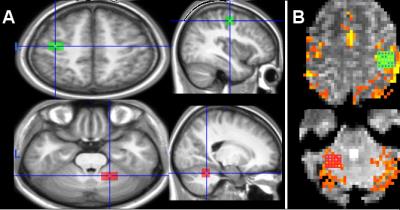 |
Real-time fMRI functional connectivity self-regulation and motor performance
Patricia Vargas, Ranganatha Sitaram, Pradyumna Sepúlveda, Cristian Montalba, Mohit Rana, Cristian Tejos, Sergio Ruiz
Brain-Computer interfaces have been used for the rehabilitation of motor and cognitive functions. They can be used to train voluntary neural activity, leading to behavioral effects depending on the targeted brain areas. The aim of this study was to test the feasibility of achieving volitional control of M1-cerebellum functional connectivity with a real-time fMRI (Rt-fMRI) system and evaluates its influence in motor performance.
Nine healthy subjects were trained in a protocol with visual feedback and motor imagery.
The results indicate that voluntary self-regulation of cerebellum-M1 connectivity is feasible with Rt-fMRI, but the effects on motor performance need to be further studied.
|
|
1690. 
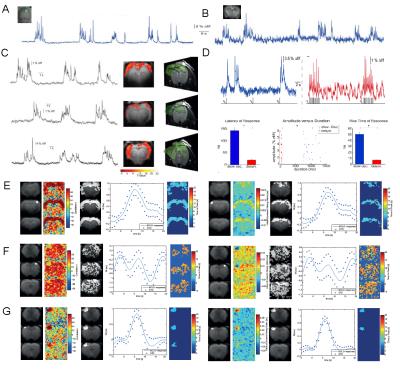 |
Spatio-temporal extent of spontaneous and sensory evoked neural network activity.
Miriam Schwalm, Felipe Aedo-Jury, Florian Schmid, Lydia Wachsmuth, Andrea Kronfeld, Hendrik Backhaus, Cornelius Faber, Albrecht Stroh
Preclinical functional Magnetic Resonance Imaging in rodents has become a vital research tool for observing functional network connectivity at rest or during sensory stimulation. There is an ongoing debate about the differential effects of anesthesia on cortical connectivity, since functional connectivity networks fluctuate depending on global brain state. We analyzed the spontaneous and sensory evoked BOLD signal in rats during different network states induced by Isoflurane and Medetomidine anesthesia, finding them to lead to fundamentally different cortical connectivity. These results are crucial for interpreting rodent studies in the framework of translational resting state research including awake human data.
|
|
1688.
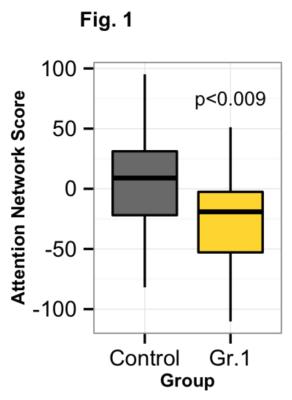 |
Connectome Based Predictive Modeling: Relating Social Measures to Functional Brain Organization
Evelyn Lake, Emily Finn, Monica Rosenberg, Xilin Shen, Dustin Scheinost, Marvin Chun, R Constable
We examine the relationship between functional brain networks and behaviour in individuals with autism from the Autism-Brain-Imaging-Data-Exchange. We find a difference in attention network strength between groups (autism vs. control) using an a priori defined network for high-attention [1]. In addition, connectome based predictive modeling (CPM) successfully predicted inattention and communication scores. Finally, on a test group of autistic patients (not used in the CPM), we found network strengths to be more similar to individuals used the CPM with autism than controls. Together, these results indicate that connectivity may prove to be a valuable tool in the diagnosis and treatment of autistic individuals.
|
|
1708.
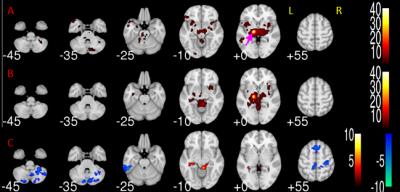 |
Altered Functional Connectivity in Essential Tremor Patients immediately following Thalamotomy using MRI guided Focused Ultrasound
Li Jiang, Jiachen Zhuo, Prashant Raghavan, Dheeraj Gandhi, Elias Melhem, Rao Gullapalli
Essential tremor (ET) is a common neurological disorder. It is often characterized by progressive tremor of the arms or hands during voluntary movements. Ablation of the ventralis intermedius nucleus (VIM) of thalamus appears to be an effective treatment for ET. However, little is known regarding changes in the brain networks among ET patients and even less regarding the network changes following the thalamotomy. This study used resting state fMRI to investigate the changes in functional connectivity (FC) in brain networks immediately after the thalamotomy and reveals reduced FC between the ablated VIM and the motor cortex and cerebellum.
|
|
1713. 
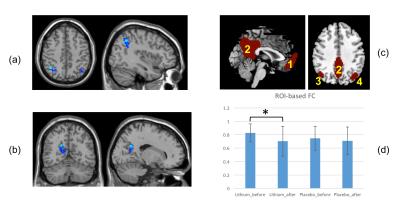 |
Effects of Lithium on resting-state fMRI in HIV-associated neurocognitive disorder
Yuchuan Zhuang, Madalina Tivarus, Eric H. Decloedt, John A. Joska, Jianhui Zhong, Giovanni Schifitto
This study firstly tested adjunctive lithium therapy in HIV patients with HAND. We examined the lithium effect using resting-state fMRI, and functional connectivity, amplitude of low-frequency fluctuation(ALFF) and fractional ALFF were calculated. We found significantly decrease of low-frequency oscillation and functional connectivity in lithium-treated group compared to placebo group, while neurocognitive performance was not different between the two groups.
|
|
1716.
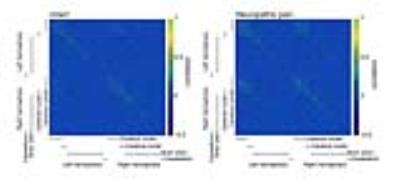 |
Phenotyping assay of neuropathic pain models using resting state functional connectivity MRI and Graph theoretical analysis
Yuji Komaki, Fumiko Seki, Keigo Hikishima, Masaya Nakamura, Hideyuki Okano
Resting state functional connectivity MRI was performed with neuropathic pain model mice.The functional network was constructed by temporal correlation analysis at the whole brain level based on the Allen brain atlas. Graph theoretical analysis was conducted to evaluate the feature of constructed networks. Compared with the intact model, degree and eigenvector centrality of neuropathic pain model showed a significant reduction in the primary somatosensory area. The clustering coefficient and local efficiency were significantly increased in the ACA. Significantly higher betweenness centrality was observed in the VPL. These results indicate that amount of information about connection to S1 was decreased. Neuropathic pain disrupt the pain matrix and the pain matrix that includes ACA and VPL may construct the complicated network. Integration of resting state functional connectivity MRI and graph theoretical analysis can evaluate the interactive complex networks of each region, not only existence or non-existence of activation region.
|
|
1718.
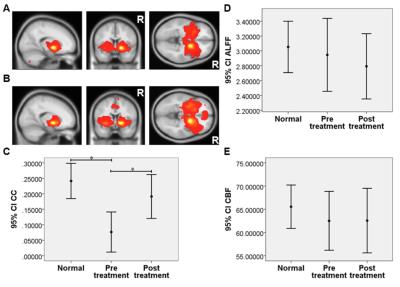 |
Enhanced striatum connectivity is irrelevant to baseline perfusion in major depressive disorder following sertraline treatment
Changwei Wu, Zi-Xuan Chang, I-Ling Chung, Chien-Yuan Lin, Ching-Po Lin, Chi-Bin Yeh, Hong-Wen Kao
We revisited the sertraline treatment effect on RSFC in drug-naïve MDD patients and evaluated the association between RSFC, ALFF and baseline CBF level. Twenty-four unmedicated MDD subjects were recruited and treated with sertraline for 6 weeks. Results showed negative correlation between HAM-D scores and striatum-MPFC RSFC. However, the therapeutic effect on RSFC was irrelevant to the CBF or ALFF levels, implying better temporal synchronizations from the neural basis.
|
|
1721.
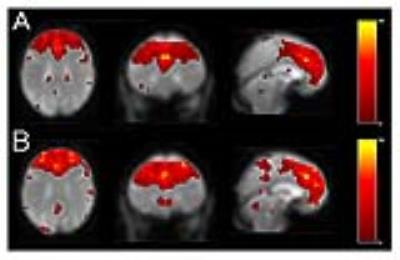 |
Modulation of Saslience Network Activation after 4 Weeks Verbal Training in Older Adults
Toshiharu Nakai, Ayuko Tanaka, Mika Ueno, Atsunobu Suzuki, Sachiko Kiyama
The potential of RSN to detect the early change of neuronal networks induced by short-term cognitive intervention was investigated by using a verbal training task to read short sentences aloud everyday for 4 weeks. Twenty community dwelling older adults participated in this study. Activation in the anterior SN was decreased after the training, suggesting optimization of salience processing to integrate visual information and language production. The SN may be potentially a biomarker to firstly reflect the change in response to cognitive interventions in older adults and this finding may be applied to optimize training protocols for each individual.
|
|
1722. 
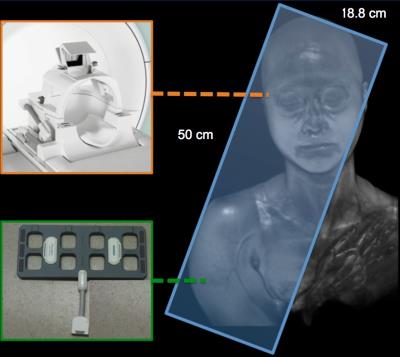 |
Functional Connection Between Brain and Right Upper-arm: A rs-fMRI Study
Chia-Wei Li, Min-Ling Lin, Jyh-Horng Chen, Wing P. Chan
This study aimed to explore the functional coupling between the central nervous system and the peripheral nervous system of upper limb. We established a novel imaging-platform to collect the functional images from human brain and upper limb simultaneously. This study disclosed the functional coupling between the peripheral nervous system of upper limb and the brain cortex and demonstrated that peripheral nervous system also involved in the regulation of brain cognitive function and related network changes.
|
|
1681.
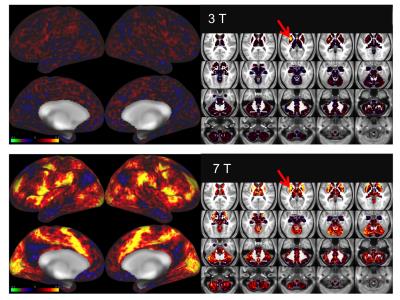 |
Tradeoffs in pushing the spatial resolution of fMRI for the 7 T Human Connectome Project
An Vu, Keith Jamison, Matthew Glasser, Steve Smith, Timothy Coalson, Steen Moeller, Edward Auerbach, Kamil Ugurbil, Essa Yacoub
Here we describe subsequent work by the Human Connectome Project (HCP), taking the initial advancements obtained at 3 T and pushing spatial resolution even further at ultrahigh field strengths. To assess the impact of spatial resolution on the resultant detectability of resting state networks throughout the brain, we compare 7 T data acquired at various isotropic spatial resolutions (2 mm, 1.6 mm, 1.5 mm, 1.25 mm, and 0.9 mm) using the 2 mm 3 T HCP rfMRI data as baseline. 7 T functional networks show enhanced BOLD CNR, resulting in sharper, stronger, and more well defined spatial detail even at the group level.
|
|
1723.
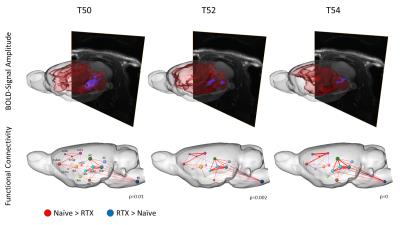 |
Network Analysis Revealed Two Distinct Neuronal Circuits Involved in Nociceptive Processing within the Rat Brain after Ablation of TRPV1-Expressing Peripheral Neurons
Isabel Wank, Lisa Kutsche, Silke Kreitz, Andreas Hess
Pain is a vital danger signal, as it prevents the body from suffering burns by hot items. Using BOLD-fMRI, we evaluated the rat's brain response to increasing thermal stimuli to detect which brain structures are involved especially in the processing of nociceptive heat. Therefore, we eradicated selectively the nociceptive-specific TRPV1-expressing neurons via Resiniferatoxin-induced excitotoxicity. This missing nociceptive input from the periphery resulted in a widespread suppression of brain activity in most brain structures except some parts of the brainstem. Graphtheoretical network analysis revealed two distinct circuits of brain structures involved in the processing of noxious temperatures above 48°C.
|
|
1724.
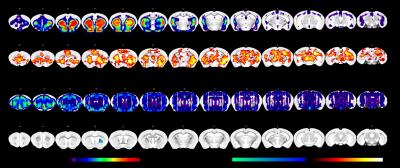 |
Interrogating neurotransmitter systems using resting-state fMRI
Joanes Grandjean, Michaela Bürge, David Bühlmann, Hannes Sigrist, Erich Seifritz, Franz Vollenweider, Christopher Pryce, Markus Rudin
We assessed functional connectivity (FC) in the mouse brain following psilocybin administration. Conventional analysis using dual regression and reference spatial maps derived from independent component decomposition identified a decrease in FC within the ventral striatum network in animals administered with psilocybin relative to vehicle. Dopamine D1 and serotonin 5HT2a receptor gene expression as well as projection maps from the ventral tegmental area and dorsal raphe nuclei obtained from the Allen Brain Institute database were used as spatial references in a secondary dual regression analysis to disentangle the contribution of dopamine and serotonin systems to whole-brain functional connectivity changes.
|
|
1712. 
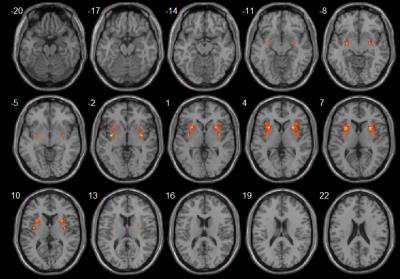 |
Increased inter-hemispheric functional connectivity in restless legs syndrome using voxel-mirrored homotopic connectivity
Yong Zhang, Kang-An Li, Yun-Cheng Wu, Zhenyu Zhou, Gui-Xiang Zhang
This preliminary study used voxel- mirrored homotopic connectivity (VMHC), a novel resting-state fMRI parameter to investigate inter-hemispheric functional activity changes in restless legs syndrome (RLS). Ten RLS patients and ten age- and gender-matched healthy controls were recruited for comparison. The RLS group showed increased VMHC in the amygdala, putamen and insula, as compared to normal controls. Increased VMHC in the insular cortex and putamen might reflect their functions in perception and motor control. Increased VMHC in the amygdalae could be relevant to the disturbed sleep at night, considering its primary role in the processing of memory and emotion.
|
|
1711.
 |
Altered Variability in Functional Connectivity of the Anterior Cingulate Cortex in Patients with Refractory and Nonrefractory Major Depressive Disorders
Bochao Cheng, Gang Ning, Yong He, Qiyong Gong
Although substantial efforts have been made to elucidate the neuronal basis of both refractory MDD (rMDD) and nonrefractory MDD (nrMDD), the results are inconsistant. We apply the resting-state dynamic functional connectivity (D-RSFC) to explore the divergence of neuroal basis between rMDD and nrMDD. Our results demonstrated that the D-RSFC method can well reveal the dysfunctional brain networks in the MDD. The prefrontal-limbic circuit is the most stable dysfunctional brain network in both MDD subtypes. Additionally, we speculate that the OFC-sgACC circuit, especially the frontal part of the left OFC-sgACC circuit, might be the biomarker for evaluating treatment response in MDD.
|
|
1693.
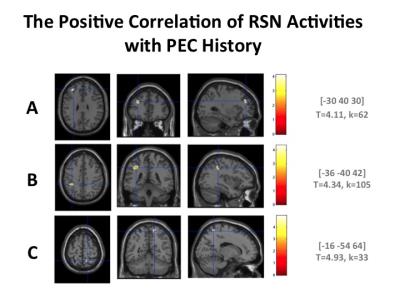 |
Dependency of the Activations Detected in Resting State Networks on the History of Physical Exercise Activities in Community Dwelling Older Adults
Mika Ueno, Sachiko Kiyama, Ayuko Tanaka, Toshiharu Nakai
In order to explore biomarkers to reflect the effects of long-term physical exercise (PE) on the activities in RSNs, the relationship among the history of participation in PE clubs, the activations in RSNs and the physical activity (PA) was investigated. The activation in the ACG was decreased depending on longer history of PE as well as higher PA indicated by IPAQ scales. These findings may reflect less demand for cognitive integration. It was suggested that both recovery and sedation of the activity in the RSNs against the age-related changes in brain activation may be the biomarker in healthy older adults.
|
|
1692. 
 |
Resting-state Functional Network Connectivity Pattern as a Cognitive Marker for Task Performance
Hua Xie, Javier Gonzalez-Castillo, Eswar Damaraju, Peter Bandettini, Vince Calhoun, Sunanda Mitra
Attentional lapses have been shown to be associated with an altered connectivity and activation pattern of the default-mode network. To further our understanding of the relationship between resting-state connectivity pattern and task performance, we analyzed a multitask dataset including four mental tasks (rest, memory, video, and math). We computed whole-brain connectivity patterns using all volumes during rest (rs-FNC), and the dynamic functional network connectivity (dFNC) patterns during tasks with a sliding window method. We compared similarity between the rs-FNC pattern and dFNCs, which was correlated to the task performance and thus might be used as a cognitive biomarker.
|
|
1725.
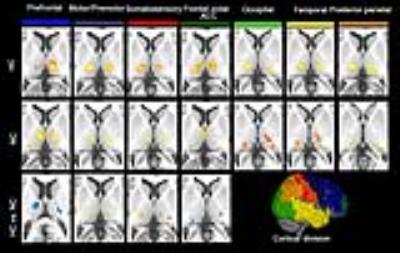 |
Thalamocortical neural responses to whole body heat exposure: A resting-State Functional MRI study
Shaowen Qian, Qingjun Jiang, Kai Liu, Bo Li, Jianxun Qu, Gang Sun
In this study, we replicated previous findings about spatially distinct thalamic correlations with cortical regions of interest. Using bi-directional functional analysis, we firstly clarified cortical-subcortical activity during hyperthermic condition by thalamocortical functional connectivity. Specifically, we found weakening connectivity of cortical fronto-polar/anterior cingulate cortex and prefrontal areas with the corresponding thalamic nuclei. On the contrary, the motor/premotor and somatosensory cortical subdivisions showed increased connectivity with thalamic nuclei. The thalamic pulvinar showed reduced connectivity with bilateral superior and middle temporal pole, but increased connectivity with bilateral middle and inferior temporal gyrus.
|
|
1714. 
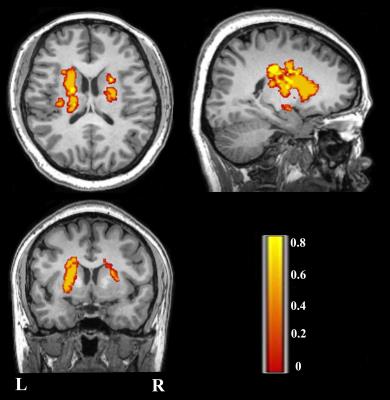 |
Altered gray matter cerebral blood flow and its connectivity indicate a potential cognitive dysfunction of chronic subcortical stroke patients
Caihong Wang, Peifang Miao, Peng Li, Jingchun Liu, Lin Jiang, Hao Liu, Dandan Zheng, Zhenyu Zhou, Jingliang Cheng
In order to investigate gray matter cerebral blood flow (CBF) and CBF connectivity alterations in chronic stroke patients, 60 patients and 60 controls were recruited to undergo 3D ASL technique. The patients exhibited increased CBFs in contralesional SFG, thalamus and ITG, and decreased CBF in ipsilesional Post_CG. Further analysis showed decreased CBF connectivity in patients in ipsilesional Pre_CG, MFG and Msfg. Importantly, the patients exhibited disconnections between the SFG and MFG, mSFG, Pre_CG. Current results suggest that stroke-induced cognitive dysfunction may be a connectivity disorder from the perspective of CBF connectivity.
|
|
1710.
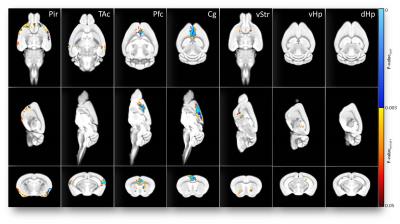 |
Towards specific biomarkers of chronic pain: Modelling behavior readouts of developing pain to resting-state functional connectivity using a developmental trajectory in a mouse model of chronic pain from bone cancer
David Buehlmann, Giovanna Ielacqua, Joanes Grandjean, Jael Xandry, Markus Rudin
We performed longitudinal behavioral readouts of pain and resting-state fMRI in a mouse model of chronic pain from breast cancer derived tibial bone metastases. The developmental trajectory of behavioral readouts was used to model the fMRI response to extract pain-specific functional connectivity changes during development of a chronic pain state. The specificity of these functional readouts was supported through inhibition of osteolytic activity, reducing the nociceptive input. Thereby, characteristic functional changes could be reduced and in some regions prevented. These results emphasize the specificity of the functional readouts for developing chronic pain and could be used to evaluate novel treatments.
|
|
1683. 
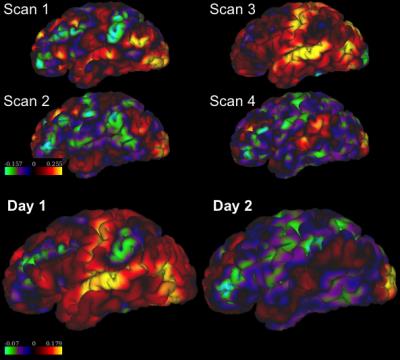 |
Is resting-state fMRI guided brain target localization for TMS reliable and reproducible?
Lipeng Ning, Joan Camprodon, Nikos Makris, Yogesh Rathi
Transcranial magnetic stimulation (TMS) is a noninvasive treatment approach for major depressive disorder (MDD). A recently proposed method1 is to stimulate a sub-region in the left dorsolateral prefrontal cortex (DLPFC) that is most anti-correlated with the subgenual cingulate (SGC) as obtained from resting-state functional MRI (rsfMRI). To test the reliability of this approach, we examined 100 data sets from the Human Connectome Project (HCP)5 with each subject scanned 4 times on two different days. We found large variability in the inter-scan rsfMRI-guided target for each subject, which can significantly reduce the efficacy of TMS therapy in MDD.
|
|
1715. 
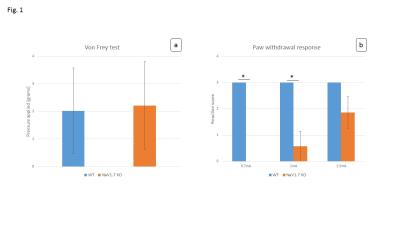 |
fMRI and spectroscopic characterization of sensory and pain processing in “pain-free” mice
Giovanna Diletta Ielacqua, Aileen Schroeter, Aline Seuwen, David Buehlmann, Jael Xandry, John N. Wood, Markus Rudin
FMRI has been widely used to assess changes in brain activity evoked by innocuous and noxious stimuli. However, stimulus-evoked fMRI (se-fMRI) measurements in mice have turned out challenging, and it is still under investigation whether and under which conditions se-fMRI applications in mice can lead to reliable readouts. Generally, se-fMRI could be a useful tool to characterize genetically modified mouse strains, such as mice exhibiting altered nociception. In this study, NaV1.7fl/fl:AdvCre mice were characterized with respect to neural processing of different types of peripheral stimuli and compared to a wildtype control group. Results of behavioral tests are compared to outcomes of fMRI and spectroscopic measurements.
|
|
1720.
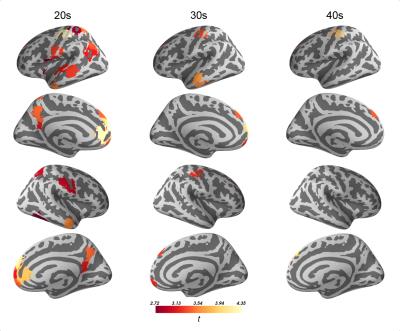 |
Relationship between static and dynamic brain functional connectivity in autism spectrum disorders
Adam Liska, Hongyuan You, Payel Das
There is an increased interest in the dynamics of brain functional connectivity, as measured via temporal covariance in resting-state fMRI BOLD signal, and its aberrations in brain disorders. We studied and compared two measures of regional dynamic behaviour, flexibility and variability, across two datasets and show that patients diagnosed with autism spectrum disorder show increased dynamic connectional variability in several brain regions. Furthermore, we establish an interesting association between static and dynamic functional connectivity measures.
|
|
1719. 
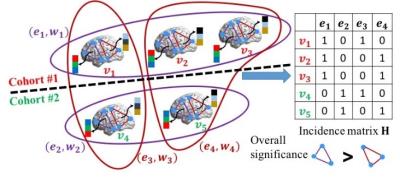 |
Learning Subnetwork Biomarkers via Hypergraph for Classification of Autism Disease
Chen Zu, Yue Gao, Brent Munsell, Minjeong Kim, Ziwen Peng, Yingying Zhu, Wei Gao, Daoqiang Zhang, Dinggang Shen, Guorong Wu
Most brain network connectivity models consider correlations between discrete-time series signals that only connect two brain regions. Here we propose a method to explore subnetwork biomarkers that are significantly distinguishable between two clinical cohorts. We construct a hypergraph by exhaustively inspecting all possible subnetworks for all subjects. The objective function of hypergraph learning is to jointly optimize the weights for all hyperedges. We deploy our method to find high order childhood autism biomarkers from rs-fMRI images. Promising results have been obtained from comprehensive evaluation on the discriminative power in diagnosis of Autism.
|
|
1717. 
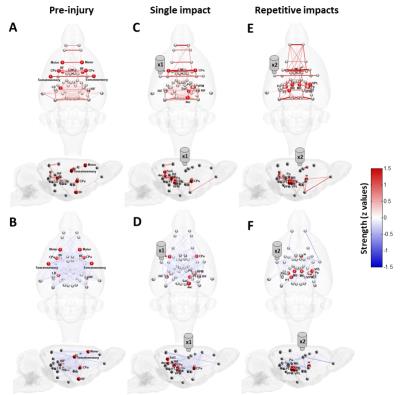 |
Reorganization of Rodent Resting-state Functional Networks after mild Traumatic Brain Injury
Chia-Feng Lu, Yu-Chieh Jill Kao, Huai-Lu Chen, Fei-Ting Hsu, Ping-Huei Tsai, Hua-Shan Liu, Li-Chun Hsieh, Gilbert Aaron Lee, Cheng-Yu Chen
Complex network analysis unraveled the mTBI-related functional reorganization with the disruption of long-distance connections of thalamocortical interactions and enhanced local connectivity segregation in the regions of neocortex and thalamic nuclei.
|
|
1694.
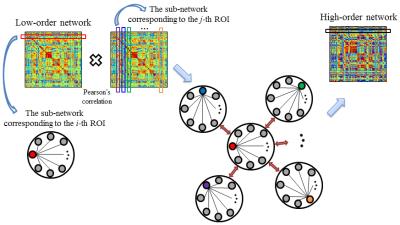 |
Hybrid high-order resting-state functional connectivity networks for mild cognitive impairment diagnosis
Yu Zhang, Han Zhang, Xiaobo Chen, Dinggang Shen
This study proposes a novel approach named “hybrid high-order FC networks” to explore the higher-level interactions among brain regions for improving the diagnosis performance of early mild cognitive impairment. We first construct the low-order network and the topographical similarity-based high-order network. With the two-level FC networks, we propose to construct a new “associated high-order network”, which is formed by estimating the higher-level interactions between the high-order sub-networks and low-order sub-networks. We further devise a multi-kernel learning strategy to integrate the dynamic networks of the three different levels. A high diagnosis accuracy of 91.5 % demonstrates effectiveness of our proposed approach.
|
|
1726. 
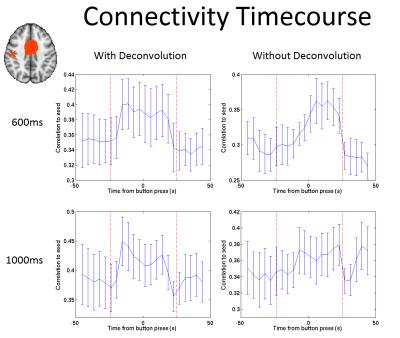 |
Use of Simultaneous Multi-Slice Imaging to Assess Dynamic Connectivity During a Self-Paced Finger Tap Task
Eleanor Barratt, Matthew Brookes, Susan Francis
Previous fMRI studies have demonstrated a number of functional networks in the brain. The introduction of simultaneous multi-slice (SMS)-imaging has allowed a larger volume coverage of the brain to be acquired with a shorter repetition time (TR), increasing temporal resolution so that dynamic connectivity (DC) measures are more achievable. Here, we use sub-second SMS-imaging to assess DC in sensorimotor networks during a self-paced finger tap experiment, and demonstrate changes in DC during individual button presses.
|
|
1682. 
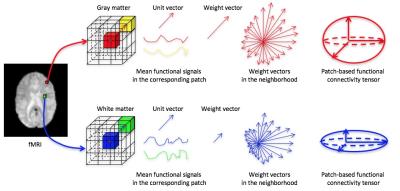 |
Spatial Registration of fMRI Data Using Functional Correlation Tensors
Yujia Zhou, Pew-Thian Yap, Han Zhang, Lichi Zhang, Qianjin Feng, Dinggang Shen
Inter-subject registration of functional MRI (fMRI) data is a key step for group analysis. Here, we propose a novel registration strategy that considers functional information from both gray matter (GM) and white matter (WM). This is achieved using functional correlation tensors (FCTs), which capture the local correlation of the BOLD signals. Features extracted from both GM and WM functional correlation tensors are utilized in a multi-channel Large Deformation Diffeomorphic Metric Mapping (LDDMM) registration framework for fMRI registration. Experimental results indicate that our method can achieve better functional registration compared with state-of-the-art methods.
|
|
1727.
 |
Relationship between GABA and glutamate and inter- and intra-regional intrinsic connectivity as measured by resting-state fMRI
Sarina Iwabuchi, Felix Raschke, Lena Palaniyappan, Dorothee Auer
Associations between GABAergic and glutamatergic systems and measures of brain connectivity have been reported previously. However, there is currently no evidence for associations between these systems and local connectivity measures, limiting our understanding of inhibitory/excitatory balance and connectivity across differing spatial ranges. We demonstrated that only regional connectivity and spontaneous activity, but not long-range connectivity, were associated with GABA and GABA/Glx ratio in the ACC. We suggest that this correlation between measures of intra-regional connectivity and GABA in the ACC may be driven by interneuron activity. Further, associations between neurotransmitter pools and inter-regional connectivity may be region/network and context-specific.
|
|
1728. 
 |
The intrinsic functional mechanism for olfactory-visual association in the human brain as quantified by fMRI
Brittany Martinez, Prasanna Karunanayaka, Jianli Wang, Xin Zhang, Bing Zhang, Qing Yang
The purpose of this study was to elucidate the reciprocal effect of olfactory-visual associations on olfactory and visual processing in the human brain using fMRI. Young, cognitively healthy participants underwent 3 separate olfactory-visual association paradigms, including either neutral, semantically congruent, or semantically incongruent visual cues. The data revealed significant olfactory activation in the POC and visual areas in response to visual cues, regardless of semantic meaning (neutral, congruent, or incongruent). This reciprocally increased activation in the POC and visual cortex during olfactory-visual cue pairing and subsequent visual cue presentations may suggest an intrinsic functional mechanism for multisensory associative learning.
|
|
1695.
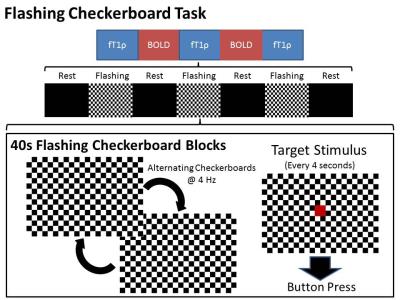 |
Functional Bold and Functional T1rho Decoupled in Bipolar Disorder
Joseph Shaffer, Casey Johnson, Jeffrey Long, Jess Fiedorowicz, Gary Christensen, John Wemmie, Vincent Magnotta
Functional T1 relaxation in the rotating frame (fT1ρ) is a new method of functional imaging that is thought to reflect changes in brain metabolism due to pH. FT1ρ may provide a more direct measurement of neuronal activity than the blood-oxygen level dependent (BOLD) contrast that is typically used for functional imaging. Here we applied both methods in order to study brain activation during a flashing checkerboard paradigm in participants with bipolar disorder as compared to controls. Linear mixed effect regression modeling revealed decoupling between the two imaging modalities in bipolar disorder in several brain regions.
|
|
